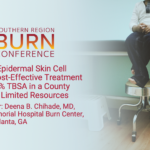Abstract | March 2, 2021
Autologous Epidermal Skin Cell Suspension: A Cost-Effective Treatment for Burns >20% TBSA in a County Hospital with Limited Resources
Learning Objectives
- Identify the benefits associated with use of autologous single-cell suspension therapy in burn patients;
- Quantify the cost-benefit associated with use of autologous single-cell suspension therapy in burn patients;
- 3) Outline the implications of integration of new technologies towards the treatment of burn patients in resource-limited healthcare settings.
Introduction: With an estimated cost of eight billion dollars per year, burn injury care places a significant financial burden on our healthcare system both at the national and local levels. Of the most vulnerable, community health centers (CHCs) intended to serve high need areas and underserved populations face a constant strain in a resource-poor environment. Based on our institutionally-created community benefit report, as of 2017, our facility provided more than $466 million in medical services to low-income and uninsured patients. Unfortunately, Medicaid reimbursement and Georgia’s Indigent Care Trust Fund provides coverage for 68% of these costs, leaving $151 million burden on our local CHC. Because of this, implementation of new innovations into common practice that benefit the patient and decrease the financial strain on the healthcare system are key to a successful burn unit.
As total burn surface area (TBSA) increases, patients often require multiple operations for definitive wound closure with autograft. Wound care plus surgically-created donor sites are a significant source of pain for patients. Additionally, time to definitive wound closure remains an important source of days added to the total length of stay (LOS). Autologous epidermal skin cell suspensions, created intra-operatively from a small biopsy with a 1-hour turnaround time, provide TBSA coverage using autograft with an achievable 1:80 expansion ratio. This provides the double advantage of allowing for wider expansion and faster healing of autograft in addition to reducing the size and number of donor sites. Due to the significant financial burden placed on CHC’s such as our facility, integrating new technology with a high upfront cost remains difficult requiring thorough analysis of both patient benefit and cost-effectiveness prior to institutional approval. Our aim was to analyze overall care of three separate patients with burns >20% TBSA, who underwent autologous epidermal skin cell suspension therapy and compare aspects of their stay including operating room trips, length of stay and overall cost per day in addition to cost of the device.
Methods: We analyzed LOS, cost of the device used to create autologous spray suspension, and operating time of three patients against the LOS at $6,795/day and operating (OR) costs found within the National Burn Repository Database (NBRD) of patients with similar demographics and TBSA injury. All cases were performed in the same operating suite within the same hospital under one surgeon.
Results: Case one includes a 22-year-old male with a 29% TBSA full-thickness burn. LOS was 10 days including one operative intervention. NBRD revealed an average 45-day LOS with two operative interventions. Using the suspension system resulted in a $218,325 savings with a 35-day LOS reduction. This comes to a $7,529 savings per percent TBSA. Case two involves a 24- year-old male admitted with a 28% TBSA full-thickness burn. LOS was 10 days during he underwent autologous single cell suspension application. Due to COVID-19 pandemic he was unable to attend regularly scheduled follow-up. He was re-admitted for LOS of 1 day due to approximate 3% TBSA graft loss due to post-operative hematoma and shear requiring an additional operative intervention for autograft. When compared to the NBRD, an average LOS was 40 days including two OR trips. With the use of autologous skin cell suspension system including the cost of the device despite a return trip due to graft loss, we note a 30-day LOS reduction with over $185,350 in savings or $6,620 per percent TBSA.
Case three is a 14-year-old female brought in for 25% TBSA full-thickness burn. She was admitted twice. Due to patient preference, she underwent conservative debridement with xenograft placement for an initial total LOS of 9 days. Due to non-healing wounds, re-admission for autograft placement with autologous single cell suspension application required a total LOS of 10 days. NBRD of patients with similar demographics report a 35-day LOS including two operative courses. With the immediate availability of an epidermal substitute utilizing autologous skin cell suspension, we calculated a 16-day reduction in LOS and $108,720 in savings equaling $4,349 per percent TBSA. If the patient underwent debridement followed by autografting with autologous skin cell suspension as advised on her initial admission, we calculate a 25-day reduction in LOS with a $150,375 in savings equaling $6,015 per percent TBSA.
Conclusion: Our CHC takes on a financial burden of up to $151 million a year in healthcare services dedicated to those who need it. Similar to other hospital systems nationwide, limited resources place a barrier before integration of new technologies with high upfront costs. Despite the high initial cost of purchasing a biopsy-to-cell-suspension system, our initial analyses reveal similar outcomes with an overall decreased LOS, less operative time, and a high reduction in overall cost when compared to demographically similar patient data within the NBRD undergoing traditional grafting. Although this remains an early analysis of a small sample of patients with burn TBSA >20%, all three cases underscore an increased savings per percent increase in TBSA. Thus, there remains the potential for even greater savings with larger TBSA patients in addition to consideration of a combined modality approach as such combined approaches may act synergistically towards the benefit of the patient.

